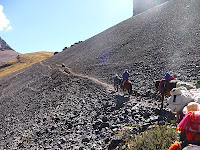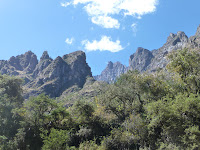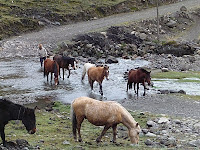

This is not a specific tourist track as such, but a walk through the spectacular Lares Valley in Peru’s. On one of the many tracks used by the local farming communities.
We travelled from the village of Huanan (2840m) in the Sacred Valley, Sth of Peru, through the Lares Valley, gradually working our way higher and higher to the Pachacutec Pass (4500m) passing many small rural Andean clusters of thatched stone houses, past lesser known Inca archaeological sites, lush lagoons and river gorges. The trek finished at the village of Lares at the natural hot springs – a great reward after 3 days of rugged, breathtaking, isolated and sometimes very difficult terrain.
Three of the group took on this challenge accompanied by a cook and his assistant, 2 porters, a wonderful guide (Juve) plus 7 horses to carry our tents, kitchen, duffle bags and weary trekkers if required. This support team was from the mountains so a great source of knowledge.
Day 1. was a “gradual” climb through lush vegetation and small farms of barley, corn and sheep following the Canchi Cancha river (one of several head waters to the Amazon River) it was small fast flowing and very rocky.
Despite spending a good amount of time at altitude we were breathless on each steep rocky climb, but the rest stops were good to really take in the magnificent scenery – towering rugged rocky peaks on either side of the narrow valley and lush vegetation along the way.
Our picnic lunch was by the river a real feast – corn soup, pan fried chicken with orange sauce, red peppers and avocado, and of course several mugs of coca tea. Hydration is important at altitude, and we were able to top up water bottles at each meal with freshly boiled water. By mid afternoon we were above the tree line at 3700mtrs and the cold afternoon wind was brisk, although still sunny. We passed several small farming communities, hugging the steep rocky hillsides. Their homes were small, one roomed stone and thatched dwellings. The whole family lived here with a small open fire for cooking and light, several bunks covered in sheep skins and alpaca rugs and a small section for the guinea pigs which are eaten as an Andian dish only on special occasions. Outside were stone walled pens, where the alpaca and sheep were housed at night.
These families would take their aninals into the mountains for grazing very early in the morning and bring then back each night, sometimes travelling several hours each way. While tending the animals the women would weave cloth or make clothing for the family. The only crop grown above the tree line is potatoes, so their staple diet 3 tines a day is potatoes and dried meat soup, with wild herbs. Excess potatoes and meat are taken to a local marked occassionally (sometimes walking for several hours to reach the market) as there are no roads or cash to own a horse to trade for some corn, rice and vegetables and social interaction. Traditional clothing of full skirts, exuibrant colours, decorated hats and ponchos were worn by the locals on the trek. Despite their apparent poverty, they appeared happy and healthy – some very shy and others keen to malke contact. Their spoken language is Ketchwa, the language of the Ibncas, so lots of “:hand” talking rather than spanish or English.
Those children that did go to school would walk up to 3 hours each way to their local community school. Only a few of these kids progressed onto secondary as they had to move away from home and often were needed to help manage their family animals and potato crops. Our first camp site was close to a small collection of stone houses – and very cold. It was -7 deg when we got up at 5.30am to see a light frost and icy tents. The dry season is from Aporil to December, so the atmosphere is extrenely dry and grasses are brown. We were surrounded by snowy capped peaks and glaciers.
Today’s trek was the most difficult with lots of long, steep and rocky ascents and descents on a narrow path, but the views again were breathtaking. Our farmer friend gave us some freshly cooked potatoes, in return for our school gifts to the children. So morning tea was on a grassy verge, eating warm spuds which were absolutely delicious.
We reached the Pachacutec Pass (4800m) after a 3 hour steep rocky climb – and again more stunning views of the Andes and the distant Lares Valley behind us. The last of this steep climb we had a rocky ride on the ponies – much easier on the lungs and we were able to enjoy more of the scenery as we travelled, rather than having to watch our step so closely. Our next steep and rocky descent took 2 hours but we could see several glacial lakes way down below, plus a small dot of our kitchen tent, which meant lunch (asparagus soup, lamb, guineoa and vegetables, mashed yellow potatoes and the local purple corn drink). The bird life around the lakes was rich and vibrant.
Again it was hot in the middle of the day and turning cold and windy by mid afternoon. We now trekked into the Quische Valley, passing thunderous waterfalls as we descended. We saw substantial farmers reeping their crops, mud brick, 2 storey houses and large areas of crops. Plus an experimental nursery propogating local trees and shrubs to re-vegitate the rocky gully’s.
It wans’t until our final day that we came on to the gravel road between Lares and Colca. It was market day at Lares and the snall central square was filled with every immaginable stall ladened with groceries, clothing, household goods, food stuffs (cereals, fruit, vegetables and meat) and of course food to eat. We tried a yummy plate of rice and mixed vegetables, eating with the locals at the communal tables. Most of the locals were in traditional dress so the square was full of colour and festivity.
Many families had walked for several hours to market with their produce, and then had to be home again in time to bring their animals into shelter.
Our last campsite was at the outdoor natural thermal springs at Lares – what a treat for the tired dusty trekkers.
It was an easy walk on our last day before travelling by bus and train to meet the rest of the group at Aguas Calientes to visit Machu Picchu.
The Lares Trek was more than we could have imagined. It was very challenging and exhilerating, and gave us an opportunity to experience a part of Andian Peru that is often not seen by overseas travellers. What a priveledge!! Our support crew and guid cared for us so well and allowed us to share parts of their lives and beautiful country – we consider ourselves hyugely priveledged.
When is the next trek!!
Filed under: Adventure travel

